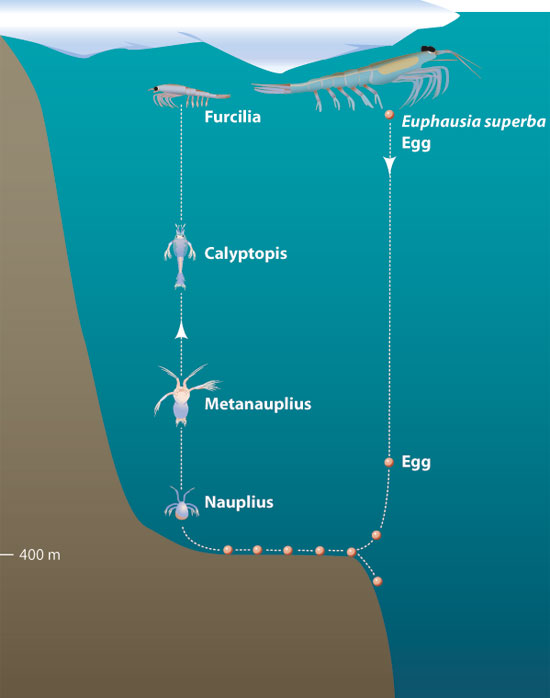Life History & Behaviour
Feeding
Krill vary highly in their main feeding style with
most feeding on zooplankton, some phytoplankton, detritus and other more
predatory. E.recurva used its
filamentous endopods to filter through sediment and also filter feed in open
waters for zooplankton. Once food is caught on the endopods it is retracted
towards the mouth whereby the maxillae move it to the mandibles and into the
mouth (Ruppert, et al. 2004).
Reproduction
The
breeding cycle of recurva has not
been comprehensively studied but the larval stages are well known and
consistent throughout the majority of Euphausiids. The genus Euphausia
generally eggs are shed freely with some species (recurva included) brooding them for some time to improve
reproduction success (Brinton, 1973). Observations of this process were made for recurva, multiple stage of development
of the eggs was made but it was found they were all expelled at a similar
stage. Euphausiaceans generally expel their eggs into the water
column near the surface and only reproduce when there are high nutrients
available. Generally higher temperatures are better conditions for spawning,
warmer waters means faster development and hence lowered chances of predation
(Dalpadado, 2006).

Development
The euphausiaceans undergo a multiple staged life cycle. The way in
which this is carried out varies with the ecology of each species but the
stages remain much the same. Once fertilisation has occurred the eggs are
released into the water column or stuck to sediment (species dependent) and begin
to undergo development (Dalpadado, 2006). The egg then hatches in to the first
larval form known as the nauplius, this larval form is used in the beginning of
the ascent to the surface and progressively undergoes development but is not
yet capable of feeding (Ikeda, 1984). The nauplius
then progresses to a metanauplius which is slightly more mobile and is
beginning to develop feeding structures. Each of these stages requires a molt
to progress to the next larval stage (Maas & Waloszek, 2001). The
metanauplius progresses to the calyptopis which is the first stage capable of
feeding and shows some form similar to that of the Euphausia body plan. The final larval stage, the furcilia is
completed near the surface which then underdoes a final molt to establish the juvenile
form of the species (Ikeda, 1984).

Picture (Life cycle)
Respiration & Movement
The euphausiacea have external gills located at the
base of the exopods. These exopods move rhythmically to assist in ventilation
of the gills. Their biramous legs (split in to at the tip) also assist in bring
fresh water in and over the gills. To swim krill use their large pleopods
(appendages extending ventrally form abdominal segments) by synchronising their
movements to propel themselves through the water column (Ruppert, et al. 2004).
Watch this video for a good visual representation of these movements (Movement)
|